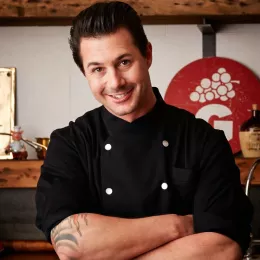Nathan Myhrvold is the lead author of Modernist Cuisine: The Art and Science of Cooking, a six-volume, 2,438-page opus released in March 2011. He is also the co-founder and chief executive officer of Intellectual Ventures, a Seattle-based company focused on creating and investing in inventions, and has nearly 250 patents in his name issued or pending.
Myhrvold first made his name in technology: he became the first chief technology officer of Microsoft after the company acquired his software firm in 1986, and remained there until 1999. His scholarly credential run far and wide, from degrees in mathematics, geophysics, and space physics from UCLA (he started college at 14) to a doctorate in physics from Princeton University earned at 23 and studies with Stephen Hawking at Cambridge University in England and Anne Willan at La Varenne Cooking School in France. Before cooking school, he spent two years as a stagiaire at Rover’s in Seattle. He has also functioned as chief gastronomic officer for Zagat Survey. He has nurtured his love of food and science-inspired cooking techniques thanks to numerous travels to the world’s best restaurants, which allowed him to get to know many of their chefs. The publication of Modernist Cuisine is the culmination of many years spent researching, writing, photographing, and editing, and even launching his own publishing company, so that the book would correspond exactly to his standards. The Main Course recently spoke to Myhrvold about the book and how he made it happen, helped by co-authors Chris Young and ICE alumnus Maxime Bilet and a large team at the Cooking Lab.
What made you decide to tackle this project?
I realized that there was an opportunity to create a comprehensive book that covers all aspects of cooking, from science to how traditional cooking works to these new techniques. If I didn’t do it, I was afraid that it’d be decades until somebody else did. The task at hand was first to see how to do it.
What was your next step once you decided to do it?
I wrote an outline, which included all the things I thought we needed to include to make a cohesive story. We pretty much followed that outline in the final book—I looked it up the other day. I found the second version of the outline, from June 2006, and it’s virtually the book that we wrote. For the last four and a half years we followed that outline. We reorganized things a little bit, of course: we initially thought it’d be one book, one big book with 600 pages.
How did you pick your collaborators?
I had worked with Wayt Gibbs, the editor in chief of the book, on a number of projects so this was a pretty natural collaboration. The next person I hired was Chris Young, whom I met at the Fat Duck [Heston Blumenthal’s avant-garde restaurant in England]. He was ready to come back to the United States, so it worked out. Then the first guy he hired was Max Bilet, who had also worked at the Fat Duck. With them the core team was in place. I initially thought I was going to take all the photos, so around that time, I hired Ryan Smith to be my assistant, but he ended up taking the majority of them.
A large number of scientists and chefs contributed their knowledge to the book and reviewed the different chapters. How did you decide to follow this peer review-like process?
We definitely made a point of having experts review each and every one of the pieces. Every chapter got some expert review. Sometimes it was a few experts, sometimes we couldn’t find more than one or two, but we had them reviewed. We wanted the book to be right.
And, is it?
Sure. If you ask me if there are any typos in the book, almost certainly we are going to find some. But in general we did a great job of making things accurate, and had an extensive copyediting process too.
What is Modernist, and why did you pick this name to define the type of techniques and food you are talking about?
There are two reasons. There was no good name to beginning with. Molecular gastronomy was the name that was most out there. But Hervé This hates if you use it to talk about cooking, and the chefs who cook in this style hate the term too. So no one was standing up saying that molecular gastronomy was a good name. It’s also a bit of a silly name. Yes, there are molecules in food, but they are in everything. So that didn’t work. Some people call it experimental cuisine. The problem I had with that is that every attempt to make a new recipe is kind of an experiment, so it doesn’t work so much as the description of a new style of cooking. Plus once we have it worked out, is it still an experiment? Some people call it Postmodernist, but what is Modernist then? So the reason is that Modernism in art, architecture, and everything was a really big trend; it shaped things in the 20th century. Modernism means making a break with the past, having an avant-garde movement that deliberately tries to be shocking, having a new aesthetic. For me, intellectually, this cuisine has all the hallmarks of Modernism. So the name felt appropriate from intellectual reasons. I have a long article in [the spring 2011 issue of] Gastronomica, which is an extension of things in the book and goes beyond what the book says, in a way, to go into the intellectual background and into the discussion of art versus craft.
At this point it’s clear that it’s not a trend: Modernist cuisine is here to stay. But what direction do you see it taking in the coming years?
There are several things to keep in mind. The first is that Modernism gave way to Postmodernism after about 100 years, roughly. Most people would say that Modernism in art went from about 1870 to the 1980s, in some level, so a good 100 years. Modernist architecture is not over, of course, but it probably was most prevalent from 1920 to 1980, so a shorter period but still 60 years. There are people who say that since Ferran Adria is retiring from his restaurant [elBulli], does this mean it’s all over? What you saw in art and architecture is that there are many movements, such as Impressionism, Cubism, Dada, Minimalism, Abstract Expressionism—there were maybe 100 schools in painting and art, which were sometimes about a single artist and sometimes about a group. We could very well be entering into a period that’s like that.
By Modernist, I mean the aesthetics and the techniques of cuisine. It’s likely that in five years you will find many restaurants that don’t have a Modernist aesthetic but will have Modernist techniques. At Italian restaurants for example, which often have a very rustic aesthetic: if they are too refined, they have a hard time as an Italian restaurant, but that doesn’t meant they can’t be interested in the techniques. So I think that many chefs will use many Modernist techniques, even if on the plate the food will look Italian rustic.
What do you consider the most groundbreaking technique included in the book?
It’s really hard to say because it depends so much on how you cook. Here’s something worth the price of the whole book if you are a professional chef. I found a paper by an Italian scientist that allows truffles to stay fresh and have more aroma longer. The answer is carbon dioxide. If you squirt CO2 in the jar, your truffles will last longer. You don’t have to have many truffles last longer to make up for the price of the book. Our omelets recipes are pretty groundbreaking. The beurre blanc is pretty revolutionary, as are our techniques to hold risotto for service and techniques for other dishes that would be easily fallible. You can cook at home 80 percent of what’s in the book. You might need a few new pieces of equipment, but they are available at places like Williams Sonoma and Sur la Table. For home cooks, we have tons of recipes using pressure cookers, techniques like making beef jerky in the microwave oven, lots of very useful things.
Some reviews have compared Modernist Cuisine to Escoffier’s Guide Culinaire, in terms of its significance for the culinary world. What do you say to that?
There are a couple of aspects to that. In my Gastronomica article, I call Escoffier the Henry Ford of the kitchen because he established the brigade system, which is sort of an assembly line. I’ve been careful to not compare myself to Escoffier. It would be difficult for me to do it. It’s also a different age now than it was then. When people say things like that, I take it that it’s a significant book that will change the course of cooking. It’s too early to say, but that’s the goal. We didn’t invent most of the techniques that are in the book. We invented some. But most of the content of the book, there was somebody somewhere who knew it, but that someone was very few people. Some techniques were from elBulli, some from the Fat Duck, some from Alinea, some from wd-50, some from that Italian scientist who wrote about truffles. That information was very hard for people to access and to get to. The people who knew that information before the book really put a lot of effort into acquiring it: they staged at a variety of restaurants, they got their hands on scientific articles, etc. It was hard to come by. We’re hoping to make it easy. By making it easy we’re hoping to profoundly impact the way people cook. We did really try to put an unprecedented amount of information into one book to make that knowledge accessible.
Do you ever feel that you have to defend the book? It has generated so much buzz, but not all of it from people who actually understand its significance.
I don’t need to defend the book, but there are a lot of people criticizing the book who haven’t seen it. They have no idea what’s in it. There are some famous farm-to-table people who, when I’ve sat down with them and shown them the book said they didn’t realize that there was anything like this. They thought of it narrowly in the context of elBulli or wd-50’s food. I love that food, but we go much beyond that. Once the book is out there, I feel that more people will understand the breadth and depth of what we cover. So I don’t feel that I have to defend it, but I certainly have to explain it to people who are quick to leap to judgment.




